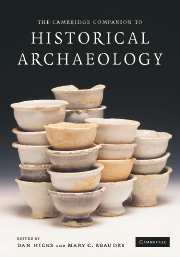Book contents
- Frontmatter
- Dedication
- Contents
- List of figures
- List of tables
- List of contributors
- Acknowledgements
- List of abbreviations
- 1 Introduction: the place of historical archaeology
- PART I ARCHAEOLOGY AND HISTORY
- PART II KEY THEMES IN HISTORICAL ARCHAEOLOGY
- PART III HISTORICAL ARCHAEOLOGY AND MATERIAL CULTURE
- PART IV HISTORICAL ARCHAEOLOGY AND LANDSCAPES
- 13 Landscapes and memories
- 14 Landscapes, ideology and experience in historical archaeology
- PART V HISTORICAL ARCHAEOLOGY AND BUILDINGS
- References
- Index
13 - Landscapes and memories
from PART IV - HISTORICAL ARCHAEOLOGY AND LANDSCAPES
Published online by Cambridge University Press: 05 July 2015
- Frontmatter
- Dedication
- Contents
- List of figures
- List of tables
- List of contributors
- Acknowledgements
- List of abbreviations
- 1 Introduction: the place of historical archaeology
- PART I ARCHAEOLOGY AND HISTORY
- PART II KEY THEMES IN HISTORICAL ARCHAEOLOGY
- PART III HISTORICAL ARCHAEOLOGY AND MATERIAL CULTURE
- PART IV HISTORICAL ARCHAEOLOGY AND LANDSCAPES
- 13 Landscapes and memories
- 14 Landscapes, ideology and experience in historical archaeology
- PART V HISTORICAL ARCHAEOLOGY AND BUILDINGS
- References
- Index
Summary
INTRODUCTION
All landscapes are ‘historical’, provided that they are now – or were once ndash; altered, inhabited, visited, or interpreted by people. Indeed, the problematic and theoretically flawed use of the terms ‘historical landscapes’ and ‘historical archaeology’ presume that only societies with written sources have ‘history’ embedded in, and mediated through, their landscapes. In fact, it can be argued that very few parts of the world do not fulfil the criterion of being ‘historical landscapes’; landscapes in which the past accumulates or is created through human action. Since landscapes can embody memories, and therefore be ‘historical’ in many different ways, this historical dimension of practically all landscapes can be actualised through material remains or knowledgeable understanding, evoking the past in the mind of the beholder (Schama 1995) and through social practice and inhabitation (Ingold 2000a). Moreover, we cannot even restrict historical landscapes to the study of human action and transformation since the ‘natural’ landscape is often itself ‘read’ by people as the result of the actions of past generations, ancestors, ancient peoples or supernatural forces (Bradley 2000). In as much as they can thus evoke, or indeed hide, the past, landscapes are linked to socially or culturally mediated remembrance and memory. By memory, we refer to the increasingly common conceptualisation of ‘social memory’ as collective representations of the past and associated social practices rather than personal recollection (see Connerton 1989; Samuel 1994). By landscape we refer to the inhabited or perceived environments of human communities in the past and present incorporating both natural and artificial elements (see Ingold 2000a [1993]; Lynch 1972).
In this essay, through a series of case studies we shall explore examples of how archaeologists, particularly those studying the last 500 years of human history, have considered the relationships between memory and landscape. This topic has in recent years attracted great interest among archaeologists dealing with this period (e.g. Lahiri 2003;Reckner 2002;N. Saunders 2003b; Shackel 2001; Tarlow 2000b) and lies now at the heart of the discipline.
- Type
- Chapter
- Information
- The Cambridge Companion to Historical Archaeology , pp. 235 - 254Publisher: Cambridge University PressPrint publication year: 2006
- 36
- Cited by



